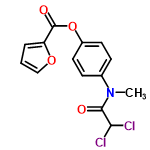Diloxanide furoate C14H11Cl2NO4 structure – Flashcards
Flashcard maker : Julia Rush
Contents

| Molecular Formula | C14H11Cl2NO4 |
| Average mass | 328.147 Da |
| Density | 1.4±0.1 g/cm3 |
| Boiling Point | 438.4±45.0 °C at 760 mmHg |
| Flash Point | 218.9±28.7 °C |
| Molar Refractivity | 78.8±0.3 cm3 |
| Polarizability | 31.3±0.5 10-24cm3 |
| Surface Tension | 52.4±3.0 dyne/cm |
| Molar Volume | 230.4±3.0 cm3 |
- Experimental data
- Predicted – ACD/Labs
- Predicted – EPISuite
- Predicted – ChemAxon
- Experimental Physico-chemical Properties
- Miscellaneous
Predicted data is generated using the ACD/Labs Percepta Platform – PhysChem Module
| Density: | 1.4±0.1 g/cm3 |
| Boiling Point: | 438.4±45.0 °C at 760 mmHg |
| Vapour Pressure: | 0.0±1.1 mmHg at 25°C |
| Enthalpy of Vaporization: | 69.5±3.0 kJ/mol |
| Flash Point: | 218.9±28.7 °C |
| Index of Refraction: | 1.600 |
| Molar Refractivity: | 78.8±0.3 cm3 |
| #H bond acceptors: | 5 |
| #H bond donors: | 0 |
| #Freely Rotating Bonds: | 5 |
| #Rule of 5 Violations: | 0 |
| ACD/LogP: | 1.42 |
| ACD/LogD (pH 5.5): | 2.34 |
| ACD/BCF (pH 5.5): | 35.23 |
| ACD/KOC (pH 5.5): | 445.58 |
| ACD/LogD (pH 7.4): | 2.34 |
| ACD/BCF (pH 7.4): | 35.23 |
| ACD/KOC (pH 7.4): | 445.58 |
| Polar Surface Area: | 60 Å2 |
| Polarizability: | 31.3±0.5 10-24cm3 |
| Surface Tension: | 52.4±3.0 dyne/cm |
| Molar Volume: | 230.4±3.0 cm3 |
Predicted data is generated using the US Environmental Protection Agency’s EPISuite™
Log Octanol-Water Partition Coef (SRC): Log Kow (KOWWIN v1.67 estimate) = 2.17 Log Kow (Exper. database match) = 2.24 Exper. Ref: Dutta,H et al. (1988) Boiling Pt, Melting Pt, Vapor Pressure Estimations (MPBPWIN v1.42): Boiling Pt (deg C): 421.30 (Adapted Stein & Brown method) Melting Pt (deg C): 159.99 (Mean or Weighted MP) VP(mm Hg,25 deg C): 1.04E-007 (Modified Grain method) Subcooled liquid VP: 2.51E-006 mm Hg (25 deg C, Mod-Grain method) Water Solubility Estimate from Log Kow (WSKOW v1.41): Water Solubility at 25 deg C (mg/L): 102.4 log Kow used: 2.24 (expkow database) no-melting pt equation used Water Sol Estimate from Fragments: Wat Sol (v1.01 est) = 1436.3 mg/L ECOSAR Class Program (ECOSAR v0.99h): Class(es) found: Esters Haloacetamides Henrys Law Constant (25 deg C) [HENRYWIN v3.10]: Bond Method : 3.73E-011 atm-m3/mole Group Method: Incomplete Henrys LC [VP/WSol estimate using EPI values]: 4.385E-010 atm-m3/mole Log Octanol-Air Partition Coefficient (25 deg C) [KOAWIN v1.10]: Log Kow used: 2.24 (exp database) Log Kaw used: -8.817 (HenryWin est) Log Koa (KOAWIN v1.10 estimate): 11.057 Log Koa (experimental database): None Probability of Rapid Biodegradation (BIOWIN v4.10): Biowin1 (Linear Model) : 0.7529 Biowin2 (Non-Linear Model) : 0.8044 Expert Survey Biodegradation Results: Biowin3 (Ultimate Survey Model): 2.2136 (months ) Biowin4 (Primary Survey Model) : 3.6075 (days-weeks ) MITI Biodegradation Probability: Biowin5 (MITI Linear Model) : 0.2157 Biowin6 (MITI Non-Linear Model): 0.0158 Anaerobic Biodegradation Probability: Biowin7 (Anaerobic Linear Model): -0.5027 Ready Biodegradability Prediction: NO Hydrocarbon Biodegradation (BioHCwin v1.01): Structure incompatible with current estimation method! Sorption to aerosols (25 Dec C)[AEROWIN v1.00]: Vapor pressure (liquid/subcooled): 0.000335 Pa (2.51E-006 mm Hg) Log Koa (Koawin est ): 11.057 Kp (particle/gas partition coef. (m3/ug)): Mackay model : 0.00896 Octanol/air (Koa) model: 0.028 Fraction sorbed to airborne particulates (phi): Junge-Pankow model : 0.245 Mackay model : 0.418 Octanol/air (Koa) model: 0.691 Atmospheric Oxidation (25 deg C) [AopWin v1.92]: Hydroxyl Radicals Reaction: OVERALL OH Rate Constant = 46.8072 E-12 cm3/molecule-sec Half-Life = 0.229 Days (12-hr day; 1.5E6 OH/cm3) Half-Life = 2.742 Hrs Ozone Reaction: No Ozone Reaction Estimation Reaction With Nitrate Radicals May Be Important! Fraction sorbed to airborne particulates (phi): 0.331 (Junge,Mackay) Note: the sorbed fraction may be resistant to atmospheric oxidation Soil Adsorption Coefficient (PCKOCWIN v1.66): Koc : 816.4 Log Koc: 2.912 Aqueous Base/Acid-Catalyzed Hydrolysis (25 deg C) [HYDROWIN v1.67]: Total Kb for pH > 8 at 25 deg C : 2.260E+000 L/mol-sec Kb Half-Life at pH 8: 3.550 days Kb Half-Life at pH 7: 35.496 days Bioaccumulation Estimates from Log Kow (BCFWIN v2.17): Log BCF from regression-based method = 1.025 (BCF = 10.59) log Kow used: 2.24 (expkow database) Volatilization from Water: Henry LC: 3.73E-011 atm-m3/mole (estimated by Bond SAR Method) Half-Life from Model River: 2.843E+007 hours (1.185E+006 days) Half-Life from Model Lake : 3.102E+008 hours (1.292E+007 days) Removal In Wastewater Treatment: Total removal: 2.54 percent Total biodegradation: 0.10 percent Total sludge adsorption: 2.44 percent Total to Air: 0.00 percent (using 10000 hr Bio P,A,S) Level III Fugacity Model: Mass Amount Half-Life Emissions (percent) (hr) (kg/hr) Air 0.000334 5.48 1000 Water 18.5 1.44e+003 1000 Soil 81.4 2.88e+003 1000 Sediment 0.101 1.3e+004 0 Persistence Time: 2.13e+003 hr
Click to predict properties on the Chemicalize site


